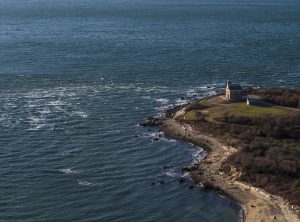
Plum Island – Telling the Story of One of the Most Mysterious Islands on the Eastern Seaboard
Thomas Halaczinsky
A documentary in production
Plum Island, located just 1.5 miles off Orient Point on the eastern tip of Long Island’s North Fork and 9 miles as the crow flies from the Connecticut shore, is most likely one of the most mysterious islands on the Eastern Seaboard. For more than 100 years, the 840-acre island has belonged to the federal government, housed an army fort, and was part of the coastal defense system protecting the back entry through Long Island Sound to New York City.
In 1948, the U.S. Army Chemical Corps took over the island when Congress allocated $30 million—$390 million in 2025 dollars—to prepare the country for possible biological war. However, in 1954, the Department of Agriculture took over the laboratory—infamously known as Lab 257—focusing on developing vaccines against highly contagious animal diseases like foot-and-mouth disease.
After more than six decades, the Plum Island Animal Disease Center bids farewell to Plum Island. The 2008 legislation regulating the move of the laboratory called for selling the island at auction to the highest bidder. A coalition of over 120 organizations of environmentalists, conservationists, historical societies, and impassioned citizens rallied to defy the sale and safeguard the island’s legacy. Meanwhile, the Montaukett Indian Nation, once the owner of the island, is fighting for state recognition. In 2018, documentary filmmaker Thomas Halaczinsky started to document the fight to preserve Plum Island. The film is currently in post-production.
As the filmmaker navigates the intricate tapestry of Plum Island, where local stories echo through time, the documentary uncovers a microcosmic American story. The talk offers a behind-the-scenes look at the production process.
Biography:
Thomas Halaczinsky is a German-American documentary director, based in Greenport, Long Island. Since 2012, Halaczinsky has been exploring New York’s island world by sailboat, documenting his journeys through photography and writing. This endeavor culminated in his book Archipelago New York (Schiffer Books, 2018), a photographic and literary logbook of his voyages.
Between 2020 and 2022 he produced and directed a three-part documentary series ARCHIPELAGO NEW YORK, commissioned by European network ARTE and national German broadcaster ZDF. The series focuses on how nature negotiates and sustains its existence in the New York metropolis. It was an official selection of the 2022 International Ocean Film Festival in San Francisco; won an Excellence Award at the Nature Without Borders Film Festival, and was awarded Best Science Film at the International Blue Water Film Festival, San Diego.
Between 2003 and 2023, Thomas produced and directed three documentaries that followed Holocaust survivor Margot Friedlander as she revisited her life story beginning at age 83: DON’T CALL IT HEIMWEH (2004); LATE RETURN (2011); and ARRIVED: MARGOT FRIEDLANDER, BERLIN. DON’T CALL IT HEIMWEH was selected as the opening film at the 2005 International Jewish Film Festival in Berlin.
Return to main page for Coastal Perspectives Lecture Series.